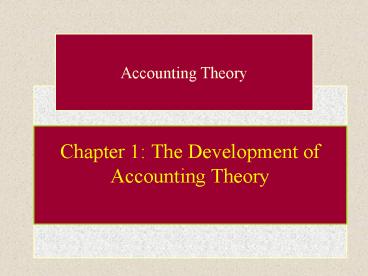Chapter 1: The Development of Accounting Theory - PowerPoint PPT Presentation
1 / 19
Title:
Chapter 1: The Development of Accounting Theory
Description:
Webster defines theory as: 'Systematically organized knowledge, applicable in a relatively wide variety of ... Enron, Worldcom and the Accounting Scandals ... – PowerPoint PPT presentation
Number of Views:2679
Avg rating:3.0/5.0
Title: Chapter 1: The Development of Accounting Theory
1
Chapter 1 The Development of Accounting
Theory
Accounting Theory
2
Introduction
- What is theory?
- Webster defines theory as
- Systematically organized knowledge, applicable
in a relatively wide variety of circumstances, a
system of assumptions, accepted principles and
rules of procedure to analyze, predict or
otherwise explain the nature of behavior of a
specified set of phenomena. - Normative theory (What ought to be how things
are supposed to work) - Positive theory (What is how things actually
work) - Why is the development of a general theory of
accounting important? - Explain why businesses elect certain accounting
methods and predict attributes of firms that
elect certain accounting methods - What is the relationship of accounting research
to accounting theory? - Verifies or refutes theory
3
Generally Accepted Accounting Principles (GAAP)
- The profession has developed GAAP that present
fairly, clearly and completely the financial
operations of the enterprise. - GAAP consists of authoritative pronouncements
issued by accounting standard setters such as - CAP, APB, FASB
4
The Financial Accounting Standards Board (FASB)
- The FASB enjoys the following advantages
compared to its predecessor, the Accounting
Principles Board - smaller membership
- greater autonomy
- increased independence of members
- broader representation on the Board
5
The Due Process (1 of 3)
- In establishing financial standards, the FASB
follows a due process procedure. - The due process gives time to interested
persons to make their views known to the
Board.
6
The Due Process (2 of 3)
7
The Due Process (3 of 3)
8
Major Types of FASB Pronouncements
- Standards and Interpretations are
modifications or extensions of standards - Financial Accounting Concepts are objectives
and concepts used in the development of
standards - Technical Bulletins provide timely guidance
on reporting issues - Emerging Issues Task Force Statements
9
GAAP Hierarchy
- LEVEL A
- FASB Statements
- FASB Interpretations
- SEC Rules and Interpretive Releases
- Accounting Principles Board Opinions (unless
amended) - Accounting Research Bulletins (unless amended)
- LEVEL B
- FASB Technical Bulletins
- AICPA Industry Audit Guides that have been
reviewed by the FASB
10
GAAP Hierarchy
- LEVEL C
- AcSEC Practice Bulletins that have been reviewed
by the FASB - Consensuses reached by the EITF
- LEVEL D
- AICPA Accounting Interpretations (no longer
issued) - FASB Implementation Guides
- Other widely recognized or prevalent accounting
practices
11
Qualitative Characteristics of Accounting
Information
- Primary Qualities are Relevance and Reliability
of Accounting Information. - Secondary Qualities are Comparability and
Consistency of reported information.
12
Qualitative Characteristics of Accounting
Information Relevance
- Relevance of information means information
capable of making a difference in a decision
context. - must be timely to be relevant.
- should have predictive value (helpful in making
predictions about ultimate outcomes). - should have feedback value (helps users confirm
prior expectations).
13
Primary Characteristics Reliability
- Information is reliable when it can be relied on
to represent the true underlying situation. - To be reliable, information must be
- verifiable
- representationally faithful, and
- neutral
14
Primary Characteristics Reliability
- Information is verifiable, when, given the same
information, independent users can arrive at the
same conclusion. - Information is faithful, when it represents what
really existed or happened. - Information is neutral, when it is free from bias.
15
Secondary Characteristics
- Secondary Characteristics
- Comparability Consistency
- To be Comparable, it must be
- measured and reported in a similar manner for
different enterprises. - useful in the allocation of resources to the
areas of greatest benefit. - useful to users in identifying real differences
between enterprises.
16
Secondary Characteristics
- Accounting information is Consistent, if the same
accounting principles are applied in a similar
manner from one period to the next. - Accounting principles may be changed, if the
change results in better reporting. - Justification for the change, and the nature and
effect of the change, must be disclosed.
17
Ingredients of Primary Qualities
18
The Full Disclosure Principle
- Financial statements must report what a
reasonable person would need to know to make an
informed decision. - Disclosure may be made
- within the body of the financial statements,
- as notes to those statements, or
- as supplementary information.
19
Accounting in Crisis The Events of the Early
2000s
- Enron, Worldcom and the Accounting Scandals
- Two major changes in the accounting profession
have taken place in the wake of the accounting
scandals - Arthur Andersen, formerly one the Big 5 audit
firms has gone out of business - In July 2002, President Bush signed into law the
Sarbanes-Oxley Bill which imposes a number of
corporate governance rules on publicly traded
companies







![[PDF]❤️DOWNLOAD⚡️ Frank Ramsey's Theory of Conditionals (History of Analytic Philosophy) PowerPoint PPT Presentation](https://s3.amazonaws.com/images.powershow.com/10047686.th0.jpg?_=20240604042)























